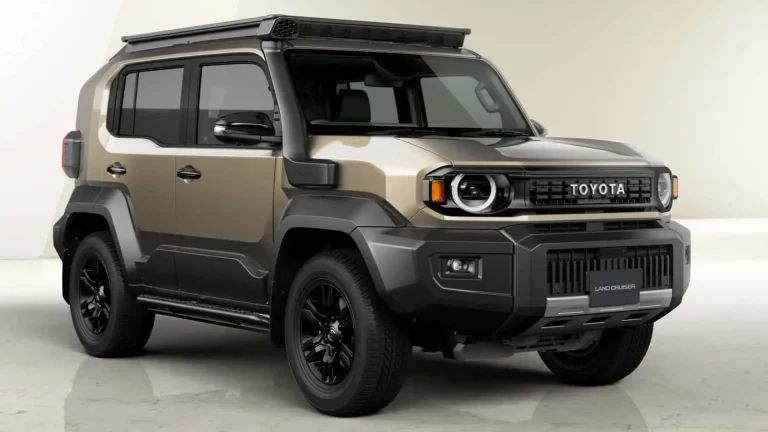Toyota has introduced a compact iteration of its iconic Land Cruiser, designed to blend the brand’s renowned off-road capability with urban practicality, marking a significant addition to its SUV lineup. Unveiled on 21 October 2025, the so-called Baby Land Cruiser targets a growing segment of drivers seeking versatile, rugged vehicles suited for both city streets and off-road trails. This launch reflects Toyota’s strategic pivot to cater to diverse market demands while preserving the Land Cruiser’s legacy of durability and adventure, as reported by Car and Driver.
The Baby Land Cruiser, officially named the Land Cruiser FJ, is a smaller, more agile sibling to the full-sized models, drawing inspiration from the classic FJ Cruiser discontinued in 2014. It features a boxy, retro-inspired design with modern touches, including sleek LED headlights and a compact footprint ideal for urban environments. According to Autocar, the vehicle is built on Toyota’s TNGA-F platform, shared with the larger Land Cruiser and Tacoma, ensuring robust off-road performance while maintaining fuel efficiency and manoeuvrability. The platform’s adaptability allows for a lighter chassis, making the FJ a compelling option for younger buyers and those navigating tighter spaces.
Powered by a range of efficient engines, including a 2.0-litre turbocharged petrol and a hybrid option, the Baby Land Cruiser prioritises sustainability without compromising capability. The hybrid variant, aligning with Toyota’s push towards electrification, offers an estimated combined fuel economy of 6.5 litres per 100 kilometres, appealing to environmentally conscious adventurers. As noted by Motor1, the vehicle incorporates advanced four-wheel-drive systems and terrain management technology, ensuring it upholds the Land Cruiser’s reputation for tackling challenging landscapes, from rocky trails to sandy dunes.
Inside, the FJ balances rugged utility with modern comfort, featuring a minimalist yet tech-forward cabin. A 10-inch touchscreen infotainment system supports wireless Apple CarPlay and Android Auto, while durable materials cater to outdoor enthusiasts. Safety features include Toyota’s Safety Sense suite, with adaptive cruise control, lane-keeping assist, and automated emergency braking as standard. The compact design offers seating for five and a flexible cargo area, making it practical for daily commutes and weekend escapes, according to Top Gear.
The launch responds to a surging global demand for compact SUVs, with the segment projected to grow by 7 per cent annually through 2030, driven by urbanisation and rising fuel costs, as per Bloomberg. In South Africa, where off-road vehicles are a cultural staple due to the country’s diverse terrain, the Baby Land Cruiser is expected to resonate strongly. Priced to compete with models like the Ford Bronco Sport and Jeep Renegade, it aims to capture a broad audience, from first-time buyers to loyal Land Cruiser enthusiasts seeking a more accessible entry point.
Toyota’s decision to revive a compact Land Cruiser variant taps into nostalgia while addressing contemporary needs. The original FJ Cruiser gained a cult following for its bold styling and off-road prowess, and the new FJ seeks to replicate that appeal with updated technology and efficiency. As reported by Automotive News, the vehicle will initially launch in key markets, including South Africa, North America, and Asia, with production ramping up at Toyota’s plants in Japan and Thailand to meet anticipated demand.
This introduction also underscores Toyota’s broader strategy to bolster its SUV portfolio amid a global shift towards versatile, adventure-ready vehicles. The company aims to capture a larger share of the compact SUV market, which accounted for 40 per cent of global SUV sales in 2024, according to Reuters. In South Africa, where Toyota commands a significant market presence—selling over 120,000 vehicles annually—the Baby Land Cruiser is poised to strengthen its dominance in the bakkie and SUV segments.
Environmental considerations are central to the FJ’s development, with Toyota committing to reduce its carbon footprint through hybrid technology and sustainable manufacturing processes. The company’s goal to achieve carbon neutrality by 2050 aligns with the inclusion of electrified powertrains, positioning the Baby Land Cruiser as a bridge between traditional ruggedness and modern eco-consciousness, as highlighted by Green Car Journal. This approach also caters to South African consumers increasingly prioritising fuel efficiency amid rising petrol prices, which have climbed 15 per cent since 2023, per BusinessTech.
The Baby Land Cruiser’s debut has sparked enthusiasm among automotive enthusiasts, with social media platforms like X buzzing with reactions to its retro-modern aesthetic and compact versatility. Early previews suggest it could redefine expectations for affordable, capable SUVs, blending heritage with innovation. As Toyota rolls out this new chapter in the Land Cruiser story, it reinforces its commitment to delivering vehicles that resonate with adventurers and urbanites alike, ensuring the brand’s enduring appeal in a rapidly evolving market.


